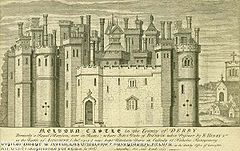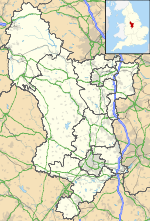- Melbourne Castle
-
Melbourne Castle Melbourne, Derbyshire 
The castle at MelbourneCoordinates 52°48′N 1°25′W / 52.8°N 1.42°WCoordinates: 52°48′N 1°25′W / 52.8°N 1.42°W Built Crenellated in the 14th century Demolished 1637 Melbourne Castle was a Norman castle in Melbourne, Derbyshire. From the early 14th century it was primarily in the possession of the Earls and Dukes of Lancaster, though it was briefly the property of the English crown. It was destroyed in 1637 by Henry Hastings, 5th Earl of Huntingdon, its final owner, who used it for building materials. All that remains of the castle today is a section of wall about 20 yards long and 20 feet high.[1]
History
According to the Domesday Book, the area was prior to the Norman Conquest the property of King Edward the Confessor, after which it passed to the hands of William I of England.[2] Though the castle is of Norman construction, it is unknown when Melbourne Castle was first built.[2] The castle was rebuilt at the beginning of the 14th century.[3] The records of Thomas, 2nd Earl of Lancaster, indicate a construction cost of £1,314 for the year of 1313-1314.[4] Application to fortify the building with crenellations had been made by Lancaster's ally, Robert de Holland, of Edward II of England; a more modest noble or royal abode may have been converted into the castle at that time.[2]
In 1322, after Lancaster was defeated at the Battle of Boroughbridge, the property passed to the English Crown until 1327, when it was bestowed on Henry, 3rd Earl of Lancaster.[4] The Duchy of Lancaster continued to improve and expand the property through the 14th and 15th centuries.[4] For 19 years, the castle served as a prison for John I, Duke of Bourbon after he was taken at the Battle of Agincourt.[3] During the Wars of the Roses, the castle was partially dismantled by the Lancastrian forces of Margaret of Anjou,[3] but as of the reign of Henry VIII the property was in good enough shape that it was described as "praty and yn meately good reparation."[4][5] In 1604, the castle passed to Henry Hastings, 5th Earl of Huntingdon who had it destroyed in 1637 so that its materials could be used in other construction.[4]
References
- ^ "Melbourne Castle". britishlistedbuildings.co.uk. http://www.britishlistedbuildings.co.uk/en-83039-castle-farmhouse-and-ruins-of-melbourne-c. Retrieved 2011-05-30.
- ^ a b c Derbyshire Archaeological Society (1895). Journal of the Derbyshire Archaeological and Natural History Society. The Society. p. 92. http://books.google.com/books?id=pewMAAAAYAAJ&pg=PA92&dq=%22Melbourne+Castle%22&lr=&as_brr=1&as_pt=ALLTYPES&client=firefox-a#PPA92,M1. (public domain)
- ^ a b c Firth, John Benjamin; Nelly Erichsen (1905). Highways and Byways in Derbyshire. Macmillan and Co., limited. p. 20. http://books.google.com/books?id=AiZAAAAAIAAJ&pg=PA20&dq=%22Melbourne+Castle%22&lr=&as_brr=1&as_pt=ALLTYPES&client=firefox-a. (public domain)
- ^ a b c d e Emery, Anthony (1996). Greater Medieval Houses of England and Wales, 1300-1500: East Anglia, Central England and Wales. Cambridge University Press. p. 422. ISBN 0521581311. http://books.google.com/books?id=FRw9AAAAIAAJ&pg=PA422&dq=%22Melbourne+Castle%22&client=firefox-a#PPA422,M1.
- ^ "pretty and in appropriately good repair."
Categories:- Castles in Derbyshire
Wikimedia Foundation. 2010.

